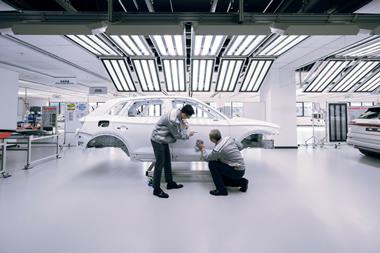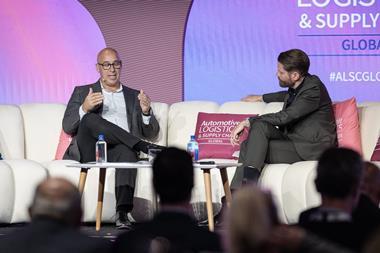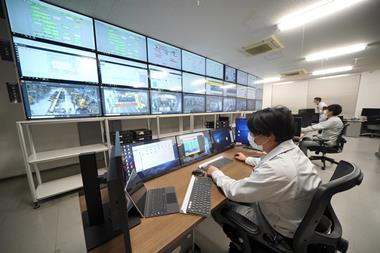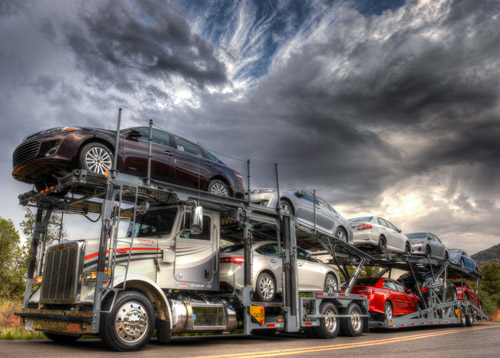 Rising sales and rail disruption may have added to the challenges posed by driver and capacity shortages, but investment, better planning and increased collaboration are laying a solid base for further expansion in the sector
Rising sales and rail disruption may have added to the challenges posed by driver and capacity shortages, but investment, better planning and increased collaboration are laying a solid base for further expansion in the sector
The continued growth in new vehicle sales in the US has ushered in new opportunities for road hauliers over the past year, with last winter’s rail backlogs resulting in an even more prominent role in the supply chain for trucks.
Rising demand is beckoning for the purchase of new trucks to increase fleets, but not all hauliers are keeping up, often because of a lengthy procurement process and limited production capacity for specialised car trailers. New trucks may take up to six months to acquire, which highlights the importance of agile equipment planning.
Contract carriers are often an important part of the equation to maintain fleet capacity (see table below), but even those with large fleets are struggling to find or hold onto adequate drivers. As a result, trucking companies are becoming more creative in their recruitment practices. Some have had to make trade-offs between driver satisfaction and OEM satisfaction, throwing on more benefits to drivers to keep them. Carriers are also investing in new IT systems, including electronic proof of delivery (ePOD), to improve their routing and delivery networks.
More broadly, there has been something of a shift in the structure of the industry. While the car haulier sector has to some degree reverted back to having very large players – most notably, Jack Cooper – there are a growing number of medium-sized carriers.
“There has been a 180-degree change from the previous industry situation. First, we had four or five large companies. Then, we had a greater number of smaller ones. The pendulum has swung back a bit, but we still have more medium-sized carriers than ever,” says Richard Binkley, president of US AutoLogistics (USAL), based in Texas.
Moving toward the large and the medium
Alex Meza, chief commercial officer at Jack Cooper Holdings, says that Jack Cooper’s fleet investment has kept pace with demand, including its acquisition of Allied Systems Holdings – formerly the country’s largest provider – last December. Jack Cooper and Allied’s networks had many similarities, which eased the transition to an amalgamated network. “Our acquisition of Allied provided us with more volume density and a broader network to improve our network. It also added operations in Canada and Mexico,” he says.

United Road acquired the assets of Waggoners Trucking in December 2013, which has greatly improved its penetration and density in certain US geographic areas, particularly toward the southeast and the southwest. Kathleen McCann, chief executive officer of United Road Services, says three main areas have influenced its efficiency in the last year: increasing demand, limited supply, and increasing regulation.
Both new and remarketed volumes are ticking up in 2014 and that trend is likely to continue, says McCann. The used car market is growing meaningfully as off-lease vehicles refill the pipeline after a return of financing. The number of new car launches, which impacts demand on the specialty side, is also at historic highs.
Besides acquisitions, some providers have seen tremendous organic growth. Moore Transport, based in Richardson, Texas, increased the number of miles it travelled by 50% from 2012 to 2013. Gary Moore, CEO predicts that its fleet size will more than double from 67 rigs at the end of 2013 to 154 by the end of this year. Moore Transport is among several vehicle carriers that have expanded geographically within the past year. Moore says that its western point of service has shifted from Toledo, Ohio to Chicago, although the company is preparing to build a terminal in Toledo. In the south it expanded routes from Newport News, Virginia to Florida. Moore will also start picking up vehicles imported by short-sea shipping from Mexico at an east coast port starting January 2015.
Going off the rails
McCann adds that capacity is tight in certain markets because of a shortage of both car hauliers and railcars (wagons). In some cases, carmakers have been willing (or forced) to increase the distance that they truck vehicles. “Customers are re-evaluating the distances that they are willing to move vehicles by truck, adjusting to the daily challenges of ensuring that the right type of railcar is at the right place at the right time,” she says.
The railways have been experiencing capacity and service problems since the beginning of the year because of bad winter weather. Following the network backlogs, there are still six or more rail facilities in the eastern US undergoing major repairs.
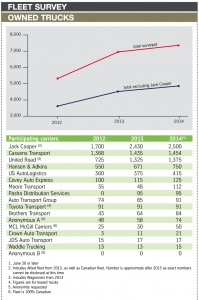
At California-based Pasha Distribution Services, the shortage of railcars has increased its average length of haul, according to John Kreisler, senior vice-president. Pasha addresses the challenges of fluctuating volumes and railcar shortages in part by keeping around 20% of its fleet as overflow, according to Kreisler.
Alex Meza points out that although the ground inventory of vehicles had been reduced following summer shutdowns, it is already showing signs of increasing. “We believe that given the continued growth in car sales in North America, rail capacity will continue to be challenged in the near to medium term,” says Meza.
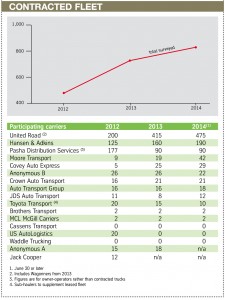
Binkley points out that USAL would not automatically accept a load of vehicles that would normally move by rail. “For example, we would not ship from Texas to California because there is no load to take back,” says Binkley.
McCann suggests demand for empty railcars is also causing inefficient processing and misplaced vehicles. “Cars are sometimes staged anywhere and everywhere, increasing load times and the risk of damage. Instead of running a more efficient network route structure that allows for higher laden miles, more trucks are required to hurry back empty to relieve the pressure in the yard,” she says.
Railcar bunching also hurts efficiency. “Land is precious and manufacturers often have to pay for additional premium capacity when the committed contractual capacity is insufficient to empty the yard.”
Quality holds or releases add to imbalances in the railcar mix. If a ramp receives 80% trucks or SUVs (instead of cars) when the norm is 40%, this greatly diminishes the load factor, wasting efficiency and capacity.
To create more capacity through efficiencies, Jack Cooper is pursuing several initiatives. One is to work with railways, OEMs, and academia to create intelligent networks. “For example, we are looking to pinpoint areas where a particular rail network may show signs of congestion. The railroad could bypass a certain interchange and receive or deliver its volume by using trucking capacity to complement its operation. This would enable the railroad to turn its assets more quickly, if they can avoid certain congested spots,” explains Meza.
Struggling to keep up
Maintaining sufficient fleet capacity is vital for handling increasing volumes. Bill Schroeder, general manager of the Auto Haulers Association of America, says it takes longer to receive delivery of the next truck than to win OEM contracts. “The Cottrells [a car carrier builder] of the world are at capacity since many companies are ordering in anticipation of new business,” he notes.
Although it does not purchase its own equipment, transport broker MetroGistics works with hundreds of carriers. William Billiter, managing partner and owner, says a major hurdle to equipment availability is trailer producers like Cottrell, which produce only four or five carriers per day. At current industry rates, 10-15 trucks fall out of service each day, so the replacement level is not high enough, while waiting periods are up to four to five months, says Billiter.
At Brothers Auto Transport, in Wind Gap, Pennsylvania, business development manager Tom Ogrodowski says fleet investment has been proportional to demand. “However, we may become understaffed if our shippers’ forecasted volumes materialise. No one knows what to expect. If the coming winter turns out to be like the last one, due to its severity, it would throw our projections off,” he says.
Ogrodowski expects Brothers Transport, a smaller player, to handle 12,000 cars this year or around 1,000 a month on average. However, the actual volumes vary. In both January and February, it handled 750 cars. In March and
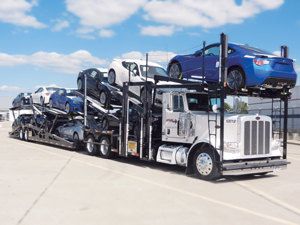
Keeping up with growing volumes has been difficult for some carriers. Mark Kahler, general manager of Covey Auto Express, based in Stockton, California, says its fleet investment is not keeping up with demand. However, the company has extended operations to western states including Washington, Nevada, New Mexico and Colorado as opportunities became available. The carrier’s fleet is somewhat different for its California business. “Of our total fleet of 154 units, 65 travel in and out of California, which has stricter emissions laws than the rest of the country. California Air Resources Board (CARB) compliance requires that engines be newer than 2012. We are still retrofitting our trucks,” he says.
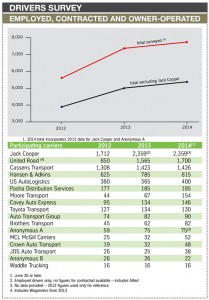
One of the pervasive challenges facing hauliers in the US is a shortage of drivers. For Brothers Auto Transport, driver availability is tight. “Implementation of the new Hours of Service (HOS) regulations affects auto rig drivers more because they must participate in the loading and unloading of the trailer,” says Ogrodowski.
Robert Farrell says the total truck driver shortage is a similar level as last year – 30,000 fewer than the industry needs. “Now, all states are making it easier for military personnel to transfer to a commercial driver’s licence,” he says.
USAL’s Binkley attributes the limited driver supply to the recession, when thousands left the industry and never returned. He estimates that the car-haul specific driver pool is around 10,000. “The industry would need 14,000 drivers, which is based on 1,200 to 1,400 cars per truck per year. For used cars, we would need twice that number,” he explains.
Bill Schroeder adds that driver turnover is high for some carriers. “For example, a trucking company may have a contract with General Motors for five years. Then GM hires another carrier and the drivers change companies. Some leave for greener grass or for signing bonuses. The rate of turnover increases as the industry gets closer to capacity.”
 "The car-haul specific driver pool is [currently] around 10,000. The industry would need 14,000 drivers. For used cars, we would need twice that number"
"The car-haul specific driver pool is [currently] around 10,000. The industry would need 14,000 drivers. For used cars, we would need twice that number"- Richard Binkley, US AutoLogistics
As Covey Auto Express struggles to keep up with equipment demand, Kahler is blunt about its driver difficulties. “It is horrible. We train and hire drivers, and the competition is phenomenal in areas such as benefits and paid vacations. Everyone wants experienced drivers, so they poach them from their competitors,” says Kahler. “It used to be customer first and driver second. Now, the situation is the opposite, sometimes. In fact, that is our biggest challenge – balancing a driver’s schedule with customer service.”
AHAA is setting up a school to provide the first month of training for drivers. It also introduced the ‘Auto Hauler Loading Manual’ earlier this year, providing best practices and a guide to safety and pre-trip inspection. “AHAA’s objective is to compete in areas that are important to the customer, such as the HOS Rules, the Affordable Care Act, etc.,” he says.
At USAL recruiting is also a challenge. Turnover is relatively high at 12-14% each year, says Binkley. To deal with this, for the past two years the company has been offering a four- to six-week training programme for experienced drivers with good records who have not yet worked as car-haul drivers. “Before, there were enough experienced drivers. Now, there are two experienced drivers out of every ten,” he says.
Looking for improvements

There are three main areas of focus. First is a weight allowance of 10% on the axles, which would increase the current limit of 80,000 pounds to 88,000 (36 metric tonnes to 39.6 metric tonnes). This would mean one more car on the truck and not on the lot. Second is a five-foot length extension from the current 75ft to 80ft (so from 22.8 metres to 24.4 metres). The third is a uniform rear overhang increase. “Since the cab size has increased due to emission controls, the distance between cars on the trailer has gotten smaller,” says Meza. “There needs to be enough distance to avoid damage.”
According to Binkley, overhang is currently non-standard throughout the industry. In general, carriers are pushing to have another 4ft in the front and 6ft in the rear. “Initially, if the new rules were to be implemented, we could not fit an extra car on the current trailers. However, with the new rules, as we renew the fleet, we could add a unit.”
Other advances can be seen in IT systems. USAL is investing in proprietary efficiency technology for introduction to the market in 2015, which would build the most efficient loads by the size and dimension of every truck, including the tilt. The system will also compile a database. “We would build loads by geography or economics in real time. Now, it is manual, which is laborious,” says Binkley.
 Gary Moore says Moore Transport’s ePOD technology is rolling out now and is on schedule for completion by November 1st. It began with Chrysler in May following the OEM’s requirements.
Gary Moore says Moore Transport’s ePOD technology is rolling out now and is on schedule for completion by November 1st. It began with Chrysler in May following the OEM’s requirements.
MetroGistics has also begun using ePOD for Chrysler, testing it for rollout in the autumn. Billiter says the system will provide administrative cost reduction, damage details, real-time tracking and other benefits, the biggest of which is determining liability. The system also geo-locates every time an activity occurs and pings the driver on its location every day to determine delivery status. MetroGistics has also developed a smartphone app which includes how to request loads, load notifications, and other features.
As vehicle hauliers experience growing pains from rising sales and transport bottlenecks, many have proven to be dynamic enough to handle demand. While that has meant dollar investments in equipment and drivers, it has also meant better planning, systems and collaboration across the sector. Whether or not there are wider shifts from rail to road, the industry is poised to grow further.
Toyota Transport is an in-house trucking fleet that Toyota Motor leases directly, an unusual (but not exclusive) example of a carmaker that controls an outbound truck fleet. Marti McFall, national logistics systems and business controls manager at Toyota Motor Sales, manages the trucking fleet. He says that within the past year, Toyota Transport has faced weather-related issues, railcar shortages, quality holds and other factors that have affected its network efficiency. To address the rail shortages, Toyota Transport deployed seven drivers and trucks to assist in moving vehicles to help with the backlog over a five-month period.
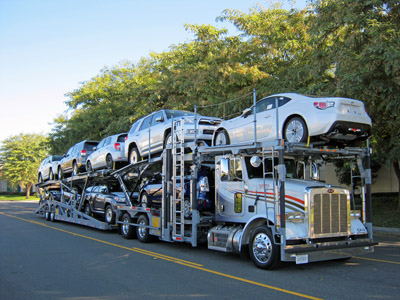
Quality modification that can hold up vehicles at ports – ‘port mods’ – have also impacted the trucking fleet. “Port mods are when Toyota places vehicles on a quality confirmation hold. We wait until quality confirmations are satisfied before we can ship the units. For this situation, Toyota Transport focuses on vehicles that are ready to ship and moves them, so that once the other vehicles are signed over, they can be shipped as well.”
At Toyota Transport, the development of an ETA system is in progress. This system will address some of the issues with inconsistent arrival times, as well as to improve dealer scheduling. Part of the objective is to be able to deliver to small volume dealers within two-to-three days.
“We are piloting a programme with the processing facilities to tender all small volume dealers together in the same truck route,” says McFall. “This will enable us to take fuller loads with fewer splits to smaller volume dealers. This system will provide these dealers with constant deliveries, and with all of their products at once, instead of holding for several days until there is enough to make a truckload.”

















